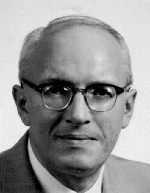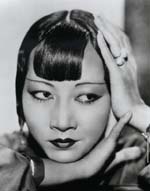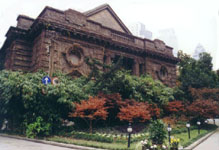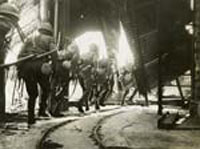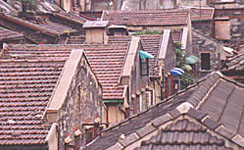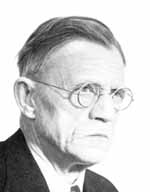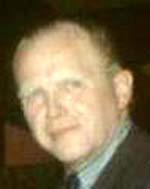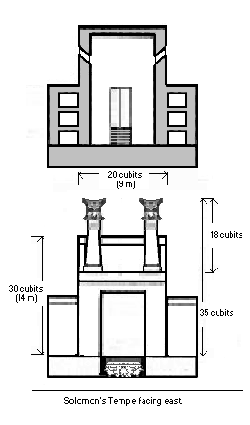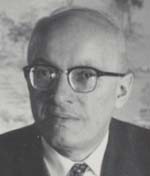Sinological Profiles
Erwin Reifler
16 June 1903 (Vienna) - 23 April 1965 (Seattle)Reifler had the blood of actors in his veins, and his story has its theatrical aspects, some of them comical. He was an Austrian unwelcome in Vienna, and a comparative philologist out of place in an age of international tensions. His best Sinological contributions remained imperfectly realized. But it can be said of him that he played his part with energy and zest, and ultimately, with some effectiveness.
His Jewish father was agnostic, but his mother was orthodox, and Erwin received a typical Jewish Sunday School education, including some Hebrew. The family were conspicuously creative: his father invented a snow removal machine; his brother was a disappointed artist; the two children of his Aunt Amalie were Shakespearean actors and owned their own theater; the son of one of those cousins became a concert pianist. Erwin's own first interest was in linguistics. A friend gave his sister Dorothea a book on Japanese haiku, and Erwin was intrigued with the Japanese writing system. Discovering that the characters were Chinese in origin fascinated him. But his first efforts to learn more about the characters were not encouraging. As he described it some years later,
Never has anybody been more discouraged from studying the Chinese language than I myself. My earliest contact with this language took place in grammar school when I was only 15 years old and my professor of Geography . . . actually said that the Chinese language and its writing were so difficult that the Chinese themselves were never able to master it completely . . . many old China hands even went so far as to tell me that the study of the Chinese characters was a very dangerous task, dangerous namely for the mind of the foreigner . . .
It was to be his lifework to make the study of Chinese not only less dangerous, but fun.
Some years later, he took up Chinese seriously under Arthur von Rosthorn at the University of Vienna. In addition to serving as von Rosthorn's teaching assistant, he was given charge of the extensive Chinese library which von Rosthorn had brought back from his ambassadorship in Peking. Seeking out Chinese speakers to improve his command of Chinese, Reifler came to frequent the Viennese Police Academy, at which many Chinese students were then being trained (the students were people of standing; they included a future Minister of Culture and a future Mayor of Shanghai). He acquired sufficient fluency to serve as interpreter for Chinese government committees. His degree at Vienna was awarded in 1931 for a thesis entitled State and Administration in Ancient China, of which it seems no copy now exists.
Reifler at this point had developed a close friendship with the American actress Anna May Wong, two years his junior, and then at the height of her career (she was working in Europe on a film starring Marlene Dietrich, which appeared in 1932). Anna May encouraged Reifler to go to China. He left accordingly in 1932, having arranged a business commission, and stayed on in Shanghai as an interpreter for the Austrian consulate, presently moving to a position as a teacher of German at Chiaotung University in Shanghai. On the side, he also gave private Chinese lessons for foreigners.
His secret as an explainer of Chinese was philological. Through examination of many languages, he had noticed some widely recurring semantic relations. The same word stem in Latin means both "cut" (as the branch of a tree) and "decide" (as a legal case). The same double meaning of one word occurs in Chinese. Take for example two characters both pronounced túng:


The one on the left means "pupil" (young boy); the one on the right means "pupil" [of the eye]. Graphically, the entire character on the left is a constituent in the one at the right. It is called the "phonetic," meaning that it carries the sound of the second character (the remaining element is the primary word for "eye"). Reifler's discovery was that the phonetic also carries the meaning; that pupil = pupil [of the eye] are the same word group, a primary word and its derivative. The connection may seem unlikely, and Reifler in this case pointed to the "pupil [young boy]" as based on the tiny figure of oneself which one can see, inverted, in the eye of another person. However the semantic derivation process may work within any one language, the linguistic fact is that the same connection is found in other languages, thus
Eng: pupil = pupil [of the eye]
Ch túng = túng [of the eye]Is this parallelism a sign that the two languages are related? Not likely. But is it merely a coincidence? Also not likely, since the same relation can be cited from other languages as well. It is instead an intrinsic semantic tendency, something that is likely to occur in a language because languages tend to work the same way.
The revealing of these semantic links, and their validation through the occurrence of the same links in other languages, makes the character series rational, and it makes Chinese as a whole amenable to rational procedures: one more of the world's languages, and not something from another planet. Something human. Just this insight was a major advance over the way in which Chinese had previously been understood, even by foreigners who, in some workaday sense, were fluent in Chinese. It gave one a sense of understanding the deep structure of the language, and it gave Reifler's teaching an assurance which his natural vividness of manner then underscored. The combination made him a great success in Shanghai.
The rise of Hitler had challenged Reifler's belief in religious tolerance and assimilation, and at this time he returned to his Jewish roots, by resuming his childhood studies of Hebrew with Reverend Mendel Brown, the rabbi of the Shanghai Sephardic Synagogue, Ohel Rachel. Reverend Brown had been called from London to this post in 1932, his family following shortly after. His path crossed Reifler's in 1936. His daughter Henrietta Brown recalls Reifler at this point:
Wishing to become more fluent, he joined my father's Sunday School class. He did not remain long in the class, as he found himself far ahead, but my father and he became good friends. After several years of study, Erwin became as expert in Hebrew as in Chinese.
Two events brought me together with Erwin: my father's invitation to celebrate the Succoth (harvest holiday) in our bamboo succah or booth, which as orthodox Jews we erected in our garden during the eight days of the holiday, and a suggestion of a friend of my mother's that we take Chinese lessons from him rather than from a teacher at the YMCA, which offered Chinese language classes for foreigners. When he came to our house, my mother broached the subject, and he agreed that my sister Lilly and I should join his class of Chinese for foreigners at a price she could afford; moreover, he arranged that the student who drove him home would also bring us home. He was a fantastic teacher because he was a real ham. Like his Shakespearean actor cousins, he had inherited a histrionic gift, but to a lesser degree. He could laugh at himself. . . He had developed a mnemonic approach to coping with the Chinese characters, breaking them into their elements and telling stories about them.
Foreseeing Hitler's invasion of Austria, Reifler brought his mother and sister Dorothea over to Shanghai in November 1936. His mother died the following March. He and Dorothea were returning from a summer cruise to Japan, but the Pacific version of WW2, which had burst into flame with the Marco Polo Bridge Incident of July 1937, interfered.
Their ship, on approaching Shanghai, found shooting going on, and could not dock. It went instead to Hong Kong, where Reifler decided to remain, giving private lessons in Chinese and German. Among his students in Chinese were the Chief of Police and the Secretary of the Chamber of Commerce. The latter became a good friend, and later recommended Reifler to the British and American Chambers of Commerce in Shanghai. Besides teaching Chinese, Reifler also explained his methods, in an address "A New Approach to the Chinese Language" delivered to the Arts Association of Hong Kong University on 9 November 1938, and subsequently published as a pamphlet.
Reifler returned to Shanghai in July 1939 to ask Henrietta Brown to marry him. The wedding took place on 20 September, at Ohel Rachel. Reifler's technical status as a "stateless person" delayed their return to Hong Kong, but his wife's British citizenship, and his recommendations from Hong Kong, eventually caused the Hong Kong authorities to relent. Their first child, named Victoria, was born there. But their stay was not long. The Japanese attack on Canton the following June caused the evacuation of women and children from Hong Kong, and Henrietta returned to Shanghai. Her husband, after remaining a short while longer in Hong Kong, joined her in Shanghai, and there they were to live for the next seven years.
On returning to Shanghai, Reifler was engaged by the National Medical College to teach German and Latin (1940-1941). Armed with the recommendation of the Secretary of the Hong Kong Chamber of Commerce, he also approached the British and American Chambers of Commerce about setting up a Chinese language class. The British Chamber declined, but the American Junior Chamber established both a beginning and an advanced Chinese class.
Things took a more tense turn with the 7 Dec 1941 Japanese attack on Pearl Harbor. The Japanese army took full control of Shanghai on the following day. Normal diplomacy was suspended, and the officials of many nations were marooned in Shanghai, awaiting repatriation. Some of them used the time to study Chinese, and Reifler's classes swelled to 100 students. Henrietta Reifler recalls:
One of these was the Czechoslovakian Ambassador, who predicted that Hitler would fight to the finish, while the Japanese Emperor would surrender to save his dynasty. And so it came to pass.
Another student, a Jesuit father, was so impressed by Reifler's teaching that he recommended him to the Rector of Aurora University, resulting in an invitation to teach his classes under the University's auspices, and permitting him to keep his fees. This arrangement lasted from 1941 to 1942. Aurora University (Université de l'Aurore) was a French establishment, the largest of three Roman Catholic colleges in China (it had 1,458 students in 1943, with another 969 in a preparatory course).
With the Japanese in control of all of Shanghai, the situation of the Shanghai Jews reached a crisis. Shanghai, with its separate French, British, and American sectors, and with Chinese Nationalist authority virtually nil, was in effect a city without a country, one of the few places in the world did that not require a visa for entry. A trickle of Jewish refugees from Germany, Poland, and Austria had begun in 1936, but by 1941 there were more than 20,000 of them, many destitute because the foreign support on which they depended had been cut off by the invasion. What now would be the Japanese policy toward them?
There was a strong strain of anti-Semitism in Japan, based on the spurious "Protocols of the Elders of Zion," which regarded Jews as a threatening world conspiracy; its extreme partisans, like the returned German student and retired Army Lieutenant General Shiôden Nobutaka, favored extermination of the Jews. Later on, in the the final Diet election of April 1942, Shiôden polled more votes than any other candidate. But the "Protocols" propaganda cut both ways. Some Japanese believed in the threat, but were impressed with the enterprise of this not numerous people. To a degree, as a small nation challenging the hegemony of several large nations, they could identify with it. For some, the myth of the dispersed Ten Lost Tribes of Israel even suggested a Jewish/Japanese relation, which had its appeal for those Japanese who had always resented the greater cultural age of China. Among this group was Navy Captain Inuzuka Koreshige, who had encountered the Protocols when in contact with the Russians following World War One. He and some like-minded officers recommended in 1939 the exploitation of the Jews for Japanese Empire purposes. Under a pen name, he published in the same year a book supporting the plan, analyzing Jewish history with relation to Japan, and suggesting that, since Palestine was closed to Jewish settlement by the British and Arabs, the Jews would seek to return to their Oriental heritage somewhere else, and that the Oriental dominions of Japan might become such a place. This would bring new talent and new wealth to these undeveloped areas, and lead to a Japanese economic advantage. There was also some thought of favorably influencing American opinion, on which Jews were not incorrectly thought to have considerable influence.
This plan for a Jewish homeland in the East was officially approved, and the cosmopolitan Inuzuka Koreshige, fluent in English, Russian, and French, was given authority in 1939 to create Jewish settlements in Shanghai. Inuzuka was in charge of Shanghai Jewish affairs in 1940-1942. The German Consul urged him to adopt an extermination policy, and offered to provide the necessary killing equipment. But Inuzuka, and the dominant government opinion back in Japan, held to the other view of the situation. He visited Jewish schools and synagogues, giving encouragement and seeking support for his plan. He directly assisted in the relocation of threatened Jews from other parts of the world to Shanghai. In 1941, Inuzuka's help in rescuing Jewish refugees from Nazi Europe was acknowledged by the gift of a silver cigarette case from the US Union of Orthodox Rabbis; it bore an inscription thanking Inuzuka for his services to the Jewish people. That inscription was later to prevent Inuzuka's being tried as a war criminal.
Such was the policy, and its background thinking, in 1940-1942. As Henrietta Reifler recalls, the Reiflers directly encountered that view in this way:
The Japanese official in charge of Jewish affairs, Captain Inuzuka Koreshige, invited Erwin and me to take tea with him at his apartment. We went reluctantly, as we were given no inkling why we were invited. It turned out that he wanted Erwin to confirm his belief that Japanese and Hebrew are related languages. He was disappointed when Erwin pointed out that modern Japanese cannot be compared with Biblical Hebrew despite seeming affinities.
A lesser philologist, or a greater politician, might have answered otherwise.
The settlement policy fell apart in late 1942, under German pressure. The Japanese occupation forces took over the entire city, parts of which had previously remained under American, British, or French control. The German Colonel Josef Meisinger, "the Butcher of Warsaw," arrived on the scene. Captain Inuzuka was transferred by the Navy to the Philippines. His successor continued to resist the extermination policy, but did set up internment camps, called "civil assembly centers." For the recent refugees, some of them Catholics of Jewish origin, a ghetto was created in Hongkew, in the former American part of the International Settlement, already crowded with the less affluent of the Jewish immigrants. In January 1943 it was ordered that all Jews who had arrived in Shanghai after March 1937 had to move to Hongkew.
There they suffered privation, recurrent flooding, an American bombing mishap, and some official Japanese cruelty. They were permitted to leave Hongkew for work outside, though a pass was required, and they had to return each night. Under these stringent but not impossible conditions, most managed to survive until the end of the war. Reifler, who antedated the March 1937 defining date, continued to stay were he was, in the former French sector, studying and writing, the latter slowly. He became a Professor at Aurora in 1943. The University's Bulletin was put at his disposal for the publication of his research results, and the first of those publications, La Langue Chinoise à la Lumière de la Philologie Moderne, appeared in that same year. Fritz Mote later asked Reifler for his opinion of Pelliot's harsh treatment of Reifler's fellow Austrian von Zach, expecting criticism of Pelliot. Instead,
Reifler I felt was very reticent, but sympathetic to the French in Sinology. He spoke especially warmly about the French in Shanghai where he taught at Aurora University, and felt that he owed them a debt of gratitude for the help they provided to him as a refugee from the Nazis.
After the first brief paper of 1943, and a second, also brief, in 1944, there was a lull. The Rector of the University admonished Reifler to be less of a perfectionist, and publish more. But the next contribution from Reifler, still not lengthy, appeared in the University Bulletin only after the war. Like his future Seattle colleague Hellmut Wilhelm, who at this time was living in Peking under analogous conditions, Reifler in Shanghai was collaborating with a Chinese scholar on a Chinese-German dictionary, but slowly. The dictionary was published only many years afterward.
At war's end, Reifler's students urged him to try to find a position more suitable to his talents. Reifler himself realized that the students he had had in Shanghai were a temporary phenomenon, and that more normal political times would reduce their number and quality. The Jewish community was leaving Shanghai. Reifler wrote in January 1946 to the British Cultural Attaché in Shanghai to inquire about the possibilities of obtaining British citizenship for himself and his children (Victoria, born in Hong Kong, Frank, born in Shanghai during the war, and Anne, then three months old). The letter included a long biographical statement, a description of his research results and their importance, and a bibliography.
This led to nothing, but a different opportunity arose when Reifler's paper was accepted for the 1947 meeting of the American Oriental Society, which he had joined in that year. The meeting was to be held in Washington DC. With assistance from his students, and from relatives in Passaic, New Jersey, Reifler made the trip. He met briefly with Einstein, another Jew who had reappraised his roots in response to Hitler. To Einstein, Reifler explained the mysteries of the Chinese characters. Somewhat more productively, he met with fellow Austrian Karl August Wittfogel, who held a dual appointment at Columbia and the University of Washington. Wittfogel recommended Reifler for a position at the latter institution. This Reifler accepted, and thus began the final phase of his career.
His linguistic discoveries were his calling card, and he was proud of them. As he had explained in his 1946 autobiographical statement to the British Cultural Attaché,
After many years of close association with the Chinese language, its writing and literature, as a student and teacher, I have been able to extract a large number of hitherto unknown and fundamental Sinological facts. On the basis of these facts I have carried on, and am still carrying on, exhaustive statistical researches covering all aspects of Chinese language phenomena, making at the same time use of the experience, and testing the applicability, of the principles and methods of foreign Philology, especially of Comparative Philology, to the Chinese language, with an ever-increasing number of amazing results. . .
The Phoneticists of the Chinese language, like the outstanding Swedish scholar Bernhard Karlgren, have specialised only in Phonetics and know too little of ancient character forms and of Chinese Semantics. This accounts for a large number of mistakes they have made in their phonetic conclusions . . .
In Seattle, Reifler liked to show to his classes a letter from the usually waspish Karlgren, acknowledging in effect that, "Yes, some of the phenomena can perhaps be explained in this way." It was the ultimate accolade to which he was open on his Sinological side.
Local success proved to be somewhat more elusive. Peace had come to the world, but academic factionalism ran high at Seattle. In linguistics, phonology rather than semantics was in style. Reifler was 44, and his English was not native. He was "less than appreciated" by some of his colleagues. In the adjoining office, the historical phonologist Li Fang-kuei was aloof. Across the hall, the polymath Leon Hurvitz was "merciless in disparaging him." Nor was he a member in good standing of the "German faction" at Seattle; Franz Michael was particularly hostile. And though students were not unreceptive to Reifler's character analysis, most of them were chiefly interested in the literary or historical aspects of the texts they were trying to read; dimensions which lay outside Reifler's zone of interest. The fit was thus less good than had been hoped.
But he started off with characteristic energy. He delivered in a paper on The Chinese Language in the Light of Comparative Semantics at the American Philosophical Society meeting of 1948. The Modern Chinese History Project at Seattle had set itself to produce an itemized abstract of the Ching Shr-lu from 1839 to 1875, and Reifler supported the effort by teaching a special daily course in translating such documents. For his basic Classical Chinese courses, he used the three volumes of Creel's Literary Chinese by the Inductive Method, substituting his own character analysis for Creel's sometimes traditional and sometimes merely weird suggestions. But Creel's books were for Reifler something more than an expensive way of acquiring large print versions of the texts on which they were based. He was prepared to defend them. In a 1953 review in Far Eastern Quarterly, he replied with considerable heat to the book's critics, though he also gently dissented from their graphic analyses:
There is, however, one aspect of this approach concerning which the present reviewer does not see eye to eye with either the author or most of his previous critics, namely the character etymologies. In a number of cases Creel has failed to indicate the fact of a "phonetic constituent" of a compound graph and has given purely ideographic or pictographic interpretations . . .
In the review he also defended the learning of the classical language as primary, by students who would later, or perhaps never, acquire fluency in spoken Chinese. His arguments were and are unanswerable, but a dominant tradition does not need to answer its dissenters. Reifler's own students, as he notes in the review, came to him after previous study of modern Chinese, and that is how it has been done, at Seattle and everywhere else, ever since. The mainstream continued to flow where it had been flowing.
In parallel with these applications of comparative semantics to Chinese language learning, there began a development that was to lead in other directions.
America at this juncture was still absorbing its WW2 Oriental experiences, which included a massive and successful effort at decoding Japanese radio transmissions, which had decisively effected the outcome, and a parallel effort under John von Neumann with computerized ballistic calculations. The latter project proceeded too slowly to affect the war, but it came into its own shortly thereafter. One of its definitive statements was Norbert Wiener's Cybernetics (1948). At the same time, in certain circles, Reifler's comparative semantics was attracting attention on its own. Visiting Matthew Sterling at the Smithsonian's Bureau of Ethnology in 1948, Reifler had discoursed on the semantic links between the words "one" and "sun" which recur in many languages. Sterling reached at random on the shelf behind him, pulled out a Cree dictionary, and demanded to know if the relationship held there also. It might not have (Reifler was well aware that his equations were natural tendencies, rather than universal facts), but it did. This deeply impressed Sterling. Reifler's findings on historical linguistics were indirectly reported to a July 1948 meeting of the Institut International d'Archeo-Civilisation in Paris. Participants were so intrigued that they convened a second meeting that December, and invited Reifler to attend. His paper "The Importance of Logography and of Comparative Semantics for Comparative Linguistics" received a warm welcome, and the Mayor of Paris gave him an inscribed scroll naming him "Ami de Paris."
These two lines of development crossed in the Sputnik years. Americans were shocked to find that the Russians, writing in a language not routinely read by Americans, were ahead of them in physics. The rapid translation of Russian physics journals suddenly became a national priority item. Warren Weaver proposed machine translation in a landmark memo of 1949. Reifler saw the memo. He rejected the idea. But on further reflection, he began to think that there might be a place here for his comparative semantics. Just as he had invited his epigraphy students to discover the meaning of unknown graphs with the aid of general semasiology, he now saw possibilities of predicting meaning in all languages. Weaver was much taken with Reifler's examples, and incorporated them into his final proposals:
For his fourth proposal, Weaver became more utopian. It was based on the belief that, just as there may be logical features common to all languages, there may also be linguistic universals. Earlier in his memorandum he commented on a paper by a sinologist, Erwin Reifler, who had remarked that "the Chinese words for 'to shoot' and 'to dismiss' show a remarkable phonological and graphic agreement." Weaver's comment was: "This all seems very strange until one thinks of the two meanings of 'to fire' in English. Is this only happenstance? How widespread are such correlations?" Obviously, Weaver thought that such universals may be very common.
This led to the idea of linguistic universals as the key to language decoding. Weaver again:
Think, by analogy, of individuals living in a series of tall closed towers, all erected over a common foundation. When they try to communicate with one another, they shout back and forth, each from his own closed tower. It is difficult to make the sound penetrate even the nearest towers, and communication proceeds very poorly indeed. But, when an individual goes down his tower, he finds himself in a great open basement, common to all the towers. Here he establishes easy and useful communication with the persons who have also descended from their towers.
Thus it may be true that the way to translate from Chinese to Arabic, or from Russian to Portuguese, is not to attempt the direct route, shouting from tower to tower. Perhaps the way is to descend, from each language, down to the common base of human communication-the real but as yet undiscovered universal language and then re-emerge by whatever particular route is convenient.
This common semantic base, if one existed, was precisely Reifler's territory. Reifler became caught up in the MT enthusiasm, and he also benefited from the prestige which the associated grant money now gave him in the Department. It acted to somewhat redress a previously missing collegial balance.
In the watershed year of 1952 appeared the second of MT theory's monuments, Claude Shannon's and Warren Weaver's book The Mathematical Theory of Communication. In June of that year, American and English linguists and engineers (with MIT linguist and philosopher Yehoshua Bar-Hillel presiding) gathered for a conference at MIT. Reifler attended, and wrote a report of the proceedings in July 1952 (not printed until 1954). In this report, he took the purist line: machine translation should do the entire job automatically, without need for expert preparation of the material, or for expert interpretation of the final product. Machine translation, in short, should be done by the machine. This was what the engineers also thought (Bar-Hillel later came to disagree). Reifler's own part in the early days of the enterprise, which began in 1952 with modest support from the Rockefeller Foundation, was a trial run with German, with electrical engineer Ryland Hill as a colleague, and Hill's student Thomas Stout as assistant.
The next volume of the journal Machine Translation contained Reifler's proposed solution to the problem of neologisms in German. The neologisms were causing trouble for the theorists by implying that the vocabulary of German was theoretically unlimited. Reifler's recommendation, which also solved the problem of limited machine memory (a serious constraint in those early days), was both simple and characteristic: Put in the machine's dictionary not the words, which are infinite and volatile, but the elements out of which they are formed, which are few and fixed. Tom Kaasa, a graduate student in Japanese art, who in the leisurely Seattle way of doing things had also taken courses with Reifler, presently joined the project as an assistant. During 1956-1960, Reifler moved up to a more "critical" language, working on Russian translation for the US Air Force with Slavic linguist Lew Mickelsen, an effort which later migrated to IBM). In 1960, with support from the National Science Foundation, he took up the problem of Chinese.
The idea of a semantic basement was soon abandoned: general linguistic tendencies are after all not the same as universal linguistic facts. The tower-to-tower approach was silently reinstated. The MT enterprise, and especially its Russian phase, had the practical merit of providing employment for a substantial number of the Seattle linguistics majors. One of these, off the record, sniffed in a mainstream way at the experiment design as mere "semantic matching." (But she took the money).
It turned out that, with suitable "pre-editing" of a Russian physics text, and with adequate "post-editing" of the English output, a quite passable translation could result. But the hope of being able to dispense with specially trained linguistic personnel at both ends gradually waned. Google users at the present day will note that modern automatic translation still stumbles at the task of distinguishing proper names from ordinary words. The 1950's team had that problem, and they also had higher-level difficulties. It turned out that Russian physicists do not cease to be Russians merely by becoming physicists, and that the diction of Pushkin may intrude, at any moment, into the supposedly simple task of putting physics thoughts on paper. Limitation of subject does (as had been hoped) diminish the linguistic problems. But not to zero.
Reifler's semasiology continued to have an outlet also in his teaching of Classical Chinese. But this was small stuff in comparison, and one early 1950's student felt that Reifler "didn't seem to care" about that class. The ongoing classroom contact with the classics did lead, however, in the mid 1950's, to an important paper on "a pious interpretative fraud in early Confucianism," involving a politically motivated commentarial misreading of a classical Shr poem.


By the late 1950's, Reifler still based his teaching on the idea that the "phonetic" part of a Chinese character (the righthand part of the righthand character above) is in many cases its semantic carrier, its "genetic" (which is both correct and important), and on the presumption that the series of characters possessing the same phonetic were the key to understanding words as they occur in literary texts. The latter presumption does not work. There is too much going on in a secondary literary way. General semantic propensities were no more firmly predictive for Classical Chinese students than they had been for Warren Weaver. The complications of language in literary context, including the literary context's annoying habit of referring to other literary contexts, unavoidably persisted.
With or without semantic connections, Reifler was mnemonically vivid. No Reifler student to this day can look at the nominalizing particle "jv" [above] without the mnemonic tag "that-thing" popping unbidden into mind. True to his theatrical roots, Reifler delivered these mnemonic equations in full voice, and reinforced them by tireless reiterations, also in full voice. By the end of the decade, Reifler had equipped himself with a series of personal eccentricities: his inevitable spats (to which he would refer at need, lifting his foot to the level of the table, as an instance of situational propriety), his pounding on the table to emphasize the meaning, or at any rate the finality, of some Chinese statement-closure particle (a device of his since Shanghai days), and the white cotton glove (used at the blackboard because of an allergy to chalk dust) which he would ceremoniously don before removing a chilled bottle of Coca-Cola ("America's greatest invention") from a desk drawer, for refreshment in mid-lesson. The opener, the opening, the inevitable but always genuine remark about the genius of the Americans in certain things (chiefly Coca-Cola), the pouring, the quaffing: it never varied. It was his not-so-private version of a tea ceremony, or a Southern colonel's ritual preparation of a mint julep.
He was ceremonious too in other respects, including the business of respect itself. Linguistics student Paul Denlinger had fallen out with his thesis advisor, Li Fang-kuei, and Reifler had saved the situation by taking Denlinger on as a student. Denlinger's feud with Li had continued, and in the next to last draft of his thesis preface, he had pointedly thanked Li "for the loan of his copy of Karlgren's Grammata Serica Recensa" - and nothing else. Reifler put his foot down, spats and all, and Denlinger's final draft read more suitably to the proprieties of the situation, and the conventions of the field.
Reifler's semasiological theories needed the sort of take-charge advocacy and critical modification that he lavished on the MT project. Toward his own work, he lacked the traits of a dynastic founder, one of which is to accept the inevitability of dynastic change. He had published several of his character series in his Shanghai days, and students in his Seattle class were required to extend this work by making a presentation on another, unpublished series. In my own presentation, I deviated at a few points from what were known to be his opinions. This he regarded, not as a loyal and constructive contribution, but as an apostasy. In a voice not quite on the brink of tears, he looked me in the eye at the end, and said,
"But you will teach it, won't you?"
It is doubtful that anybody did teach the character-series approach in the form in which Reifler left it. For one thing, he left it incomplete. But the gist of the theory has been dispersed within Sinology. It may be said to be familiar doctrine, though Reifler's name is unknown to many of those who hold that theory, and whose understanding of Chinese has benefited from it. These people are his disciples unaware.
For all the enthusiasm of Reifler's class presentations about the characters, his philological mind seemed to have gone on to other things. The focus that continually percolated into the class hour was ancient metrology. This had been an interest since his studies of the Hebrew Bible in Shanghai. The measurements of Solomon's temple at Jerusalem are reported, but confusingly, in the Book of Ezekiel. The task for scholarship was to determine a unit of which the various dimensions of the Temple were multiples. This in turn requires an understanding of the whole Hebrew system of weights and measures, a task which quickly involves one with the metrology of the Ancient Near East. It turned out that some measures, not only in Israel but in Babylonia, still had modern descendants. This somewhat shook Reifler's general stance of cultural modernism. "Of course I favor the metric system, but now, when I see how far back the English inch goes . . ."
The shift of focus came as early as 1951. Reifler's paper "Another Pious Interpretative Fraud in the Tso Chuan" promised to take his earlier Shr researches a step further. It was "read by title only" at the November meeting of the Western Branch of AOS. Reifler had however been present in person at the Midwest meeting of the Society of Biblical Literature the preceding April, to present his paper on "The Semantic Parallelism of Job 5:3." This was also read to a study group of interested Seattle rabbis and cantors who had invited the Reiflers to attend.
In 1955, Reifler did read a paper on a Sinological subject, "The Mysterious Lü in the Chapter The Punishments of Lü in the Shu Ching," but in 1959 his paper for the Western Branch of AOS was on "Eurasian Metrology." In that same year he posted a query for the historians of science in the journal Isis:
In the article "Weights and Measures" in the ninth edition of the Encyclopedia Britannica (page 485) a rabbinical rule is referred to, according to which the volume of the ancient Hebrew liquid capacity measure called bath is equal to the volume of half a cubit, cubed. Does any reader of Isis know where this rule may be found?
By 1962 he seemed to have been split three ways. Of the three, metrology was getting his best efforts. In December of that year he read to the Archaeological Institute of America a paper on The Evidence for the Near Eastern Origin of the Doric and the Parthenon Foot Standard. But he was absent the following March at the Western Branch of AOS, where his paper on The Real Meaning of the Chinese Name of the Analects of Confucius was read by Don Gibbs, and his paper on Foreign Machine Translation (MT) Development and its Effect on Chinese Language Studies was read by Stella Chien. In December 1964, he read another metrology paper, "Additional Evidence for a Prehistoric Link Between the Measuring Systems of Sumeria and the Indus Valley," to the Archaeological Institute meeting:
Excavations in the Indus Valley have in recent decades brought to light a considerable number of cubic weights of a weight standard and several specimens of a linear standard. In a paper read before the American Oriental Society in 1959, we have already submitted some evidence for an extraordinary metrological agreement between the weight standards of Sumeria and the Indus Valley. Our present paper will submit additional evidence suggesting a link between both metrologies unlikely to be coincidental.
Again the larger connections, rooted in precise philology and issuing in a human universal.
Metrology and Chinese clasped hands at the end, in a paper on the Sumero-Babylonian origin of the Chinese system of measures, and another in "The Philological and Mathematical Problems of Wang Mang's Standard Grain Measures." The latter was contributed to a 70th birthday volume for Li Ji. It was almost his last flicker as a Sinologist.
Reifler had not become indifferent to his original comparative semantic researches, but for their development, and for the completion of a Chinese dictionary on character-series principles, he had counted on a long and leisurely retirement. This was not to be granted him. He died in April 1965, three years short of retirement age. The Rector of Aurora University had been right: Reifler needed to publish his key findings faster.
Their posthumous publication immediately ran into problems. Don Gibbs, who assisted the family at this time, recalls the condition of Reifler's papers:
After Reifler died, someone carried the contents of his files to the basement in his home using cardboard boxes. At one point there must have been a shortage of boxes, for some of the papers were just dumped into a large pile about three feet high and spread out over maybe fifteen feet in a circle. I spent many days and nights sorting out the papers. Paper clips became unfastened, so it was an awful mess.
Some of Reifler's Western language books were sold at this time to individuals, including students. I have in my attic at this moment a number of exotic language textbooks and dictionaries, including some rare items which Reifler did not own, but had had Xeroxed and bound. All are used; some are patched with tape. By Reifler. They had been his semasiological stalking ground.
His Chinese library eventually went as a unit to the University of Illinois (Champaign-Urbana), where it forms one of three legs of that institution's Sinological resources. The University of Washington librarians, to whom Reifler's papers had been given, threw out the notes for Reifler's dictionary, keeping only his personal correspondence. A young former colleague, Richard Yang, who later expressed an interest in picking up the dictionary project, thus found nothing left to pick up. It was no more.
In MT terms, Reifler's Nachlass as a whole did not find its post-editor. His unpublished metrological paper on the Foot of Chou appeared posthumously, as edited by Don Gibbs for the the 1970 Festschrift for his Seattle colleague Hellmut Wilhelm. Gibbs also made efforts with several other manuscripts:
I sent samples and a proposal to several university presses, but all were dismissed out of hand. More than just dismissals, they sought to discourage me from ever darkening their door again.
As for the metrology studies, Henrietta Reifler recalls that at the time of Reifler's death:
Erwin belonged to many learned societies, but the only one that wrote to express regret was the British Metrological Circle. I wrote to thank them for their condolences and suggested that perhaps one of their members would like to work on his notes and prepare them for publication, so that the knowledge contained within them would not be lost. A Mr H John Griffin, who worked in the Office of Weights and Measures in Croyden, volunteered, so I sent the materials to him. Mr Griffin worked diligently for twelve years and produced two volumes: Ancient Hebrew and Solomonic Building Construction, and A Comparative History of Metrology.
Finding a publisher for both books was quite difficult as the subject is esoteric . . . After I retired and had time to look into the matter, I approached Mansell Publishing Limited in London, who agreed to publish them on microfiche. As Mr Griffin had worked on them for twelve years night after night without pay, the children and I agreed to give him the rights, and I understand from him that there are still requests for both publications.
Reifler's SBL paper on parallelism in Job had been sent to a journal in Holland, which rejected it because the footnotes did not follow that journal's preferred form. It was never reworked for resubmission, and the onionskin copy was still among his papers at his death. It gained a new life from the Seattle study group before which it had also been read. Henrietta remembers:
Worried that such a flimsy copy would not survive, I asked my niece, who was visiting me from Johannesburg, to type it out for me. She did so, and I wrote in the Hebrew letters, and must have filed both copies. It was several years later that one of the Rabbi's congregants, a friend of mine, told me that the Rabbi, who had moved to New York State, had written her to ask me what had become of the article on Job. I wrote to him and sent him the typed copy. He found my Hebrew writing so bad that he could not read it. I looked for the original copy but could not find it so we had to let the matter rest. Later when I had to move to the East Coast and had to dispose of most of my belongings, I found the original copy and sent it to him.
He in turn sent it to the Jewish Bible Quarterly in Jerusalem, which published it in 1998. In the process, Israel became Reifler's last academic home. Thus do work, and reputation, slowly settle into final form.
In any group of mid-century Seattle profiles, Reifler's is inevitably the scherzo movement. He himself played it that way. But through it all there persists a certain contagious philological passion. His colleague Hellmut Wilhelm's children, and Hsiao Kung-chuan's, sought more conventional, less scholarly, careers than their fathers. Reifler's children show a different tendency. Victoria, an anthropologist at Tulane, has written a Maya Dictionary of her own and collaborated on Mayan archaeoastronomy; Frank, a mathematician at Lockheed Martin, has a publication record in mathematical physics; Anne, only two when she left Shanghai but proud to have been born there, was later a student of Chinese at the University and is now (2004) a high school special education teacher in Anchorage, Alaska; Consuela is currently learning Spanish, Portuguese, and Hebrew on her own; and Caela teaches Hebrew to fifth graders in Baltimore. Her mother remarks of Consuela:
When I hear Consuela discussing the fine points of Spanish and Hebrew grammatical idioms, I think I am listening to her father. It is amazing!
Somehow, Reifler conveyed in his own family circle the importance of learning and teaching, the fascination of language, and the value of precision with language. Thus do his philological and his Rabbinical sides, his theatrical and his committed aspects, come together in the end as a dedication to learning.
That personal heritage, a better understanding of how the Chinese characters work, and the key philological papers, represent his legacy. The semasiology of Chinese has passed, in general terms, into the common understanding. The critical studies of classical Chinese texts are an open legacy, one still inviting development. That Reifler is now chiefly remembered as one of the founding figures of Machine Translation seems to many of us a mere digression from his own proper mainstream.
E Bruce Brooks
References
There is no complete list of Reifler's publications. Those included within the list below, along with other sources for the present sketch, are merely illustrative.
- Erwin Reifler. A New Approach to the Chinese Language. Arts Association of Hong Kong University 1938
- Erwin Reifler. La Langue Chinoise à la Lumière de la Philologie Moderne. Bulletin de l'Université de l'Aurore 3ser v4 #2 (1943) 419-434
- Erwin Reifler. Étude sur l'Étymologie des Caractères Chinois. Bulletin de l'Université de l'Aurore, 3ser v5 #1 (1944) 1-36
- Erwin Reifler. Contribution de la Philologie Chinoise à la Philologie Mondiale. Bulletin de l'Université de l'Aurore 3ser v7 #1 (1946) 31-50
- Erwin Reifler. Nature Complémentaire des Philologies Chinoise et Étrangères. Bulletin de l'Université de l'Aurore 3ser v9 #36 (1948) 98-106
- Erwin Reifler. La 'Fission de l'Atome' en Sinologie à l'Aide de la Sémantique Comparative. Analyse des Associations Préhistoriques d'Idées qui en Résultent (Découverte d'un Aspect Nouveau en Sinologie. Bulletin de l'Université de l'Aurore 3ser v10 #38 (1949) 239-254
- Erwin Reifler. Linguistic Analysis, Meaning, and Comparative Semantics. Lingua 3 (1952/53) 371-390
- Erwin Reifler. The First Conference on Mechanical Translation. Mechanical Translation v1 #2 (August 1954) 23-32. This report, written in July 1952, summarizes a conference of June 1952
- Erwin Reifler. Review of Herrlee Glessner Creel, Literary Chinese by the Inductive Method. FEQ v12 #3 (May 1953) 340-343
- Erwin Reifler. "Ever Think of Your Ancestor!" A Pious Interpretative Fraud of Early Confucianism and Its Consequences for the Formal and Semantic Interpretation of the Wen Wang Ode. MS v14 (1949-1955) 340-377
- Erwin Reifler. Mechanical Determination of the Constituents of German Substantive Compounds. Mechanical Translation v2 #1 (July 1955) 3-14
- Erwin Reifler. The Philological and Mathematical Problems of Wang Mang's Standard Grain Measures: The Earliest Chinese Approximation to p, in Chingju Li Jiwvn Syenshvng Chishrswei Lunwvn Ji (1965)
- Erwin Reifler. The Archaeological and Metrological evidence for an Indus Valley and Sumero-Babylonian Origin of the Ancient Chinese Measuring System, in R N Danekar (ed), Proceedings of the Twenty-Sixth Congress of Orientalists v4 (1970) 139-162
- Erwin Reifler. The Foot of Chou and the Span of Han. MS v29 (1970-1971) 419-422
- Marvin Tokayer and Mary Swartz. The Fugu Plan: The Untold Story of the Japanese and the Jews During World War II. Paddington 1979
- H J Griffin. Ancient Hebrew and Solomonic Building Construction: Compiled From the Notes of Dr Erwin Reifler [microfiche]. Mansell 1984
- H J Griffin and Erwin Reifler. A Comparative History of Metrology [microfiche]. Mansell 1984
- Victoria Reifler Bricker. Epigraphy. Texas 1992
- Victoria Reifler Bricker. A Dictionary of the Maya Language as Spoken in Hocubá, Yucatán. Utah 1998
- Erwin Reifler. Semantic Parallelism in Job 5, pt I. Jewish Bible Quarterly v26 #3 (#103, July-Sept 1998) 143-148
- Erwin Reifler. Semantic Parallelism in Job 5, pt II. Jewish Bible Quarterly, v26 #4 (#104, Oct-Dec 1998) 216-222
- Martin Kern. The Emigration of German Sinologists 1933-1945. JAOS v118 #4 (1998) 507-529. The Reifler entry is at p522f.
- W John Hutchins (ed). The Early Years of Machine Translation. John Benjamins 2000. The chapter on the Reifler period at the University of Washington is by Reifler's Seattle colleague Lew Mickelsen
- Bernhard Führer. Vergessen und Verloren. Projekt 2001. The Reifler chapter is at p245-265; the 1946 autobiographical statement occupies p257-265
- Erwin Reifler's Chinese library (at Illinois/Champaign-Urbana)
- Henrietta Reifler's papers (at the Jewish Women's Archive; use Search window)
Don Gibbs, Fritz Mote, Henrietta Reifler, and Victoria Reifler contributed to this profile.
9 Jan 2007 / Contact The Project / Exit to Sinology Page
